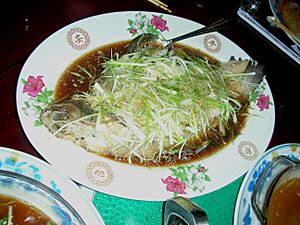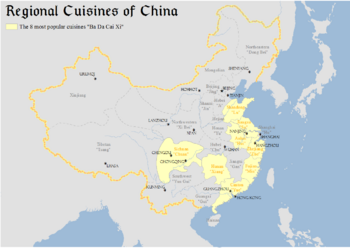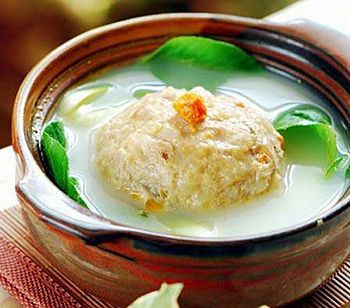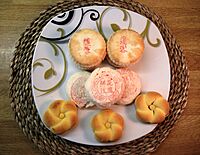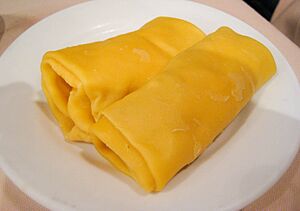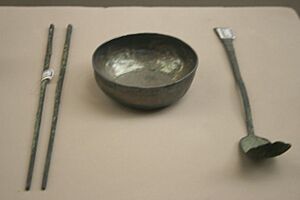Chinese cuisine facts for kids
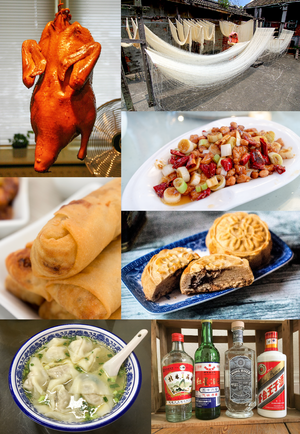
Chinese cuisine is all about the amazing food from China and from Chinese people living around the world. Chinese food has had a huge impact on many other cuisines in Asia and beyond. This is because Chinese people have traveled and shared their cooking traditions for a long time.
You can find Chinese food items like rice, soy sauce, noodles, tea, chili oil, and tofu everywhere now. Even cooking tools like chopsticks and the wok are used globally. The very first places that looked like modern restaurants appeared in China during the 11th and 12th centuries, in the Song dynasty. Also, Street food became a big part of Chinese food culture during the Tang dynasty.
The way Chinese food is made and seasoned changes a lot across different parts of China. This depends on things like social class, religion, and ethnic groups. The land itself, with its mountains, rivers, and deserts, also affects what ingredients are available. China's climate ranges from warm in the south to very cold in the northeast. Even the food choices of emperors and nobles have shaped Chinese cooking over time. As China grew and traded with other places, new ingredients and cooking styles were added to Chinese cuisine.
There are many different styles of Chinese food, based on regions, religions, and ethnic groups. Chinese cuisine is very diverse! It's often grouped by provinces, but each province has even more unique styles within it. Long ago, during the Qing dynasty, four main styles were famous: Sichuan, Shandong, Cantonese, and Huaiyang. These represented the west, north, south, and east of China. Later, in 1980, a journalist named Wang Shaoquan listed the Eight Cuisines of China. These are Anhui, Guangdong, Fujian, Hunan, Jiangsu, Shandong, Sichuan, and Zhejiang.
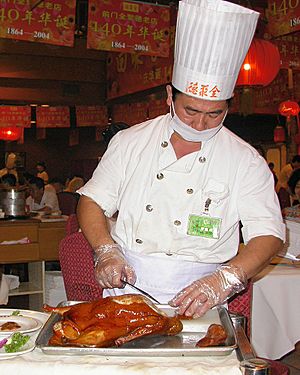
Chinese cooking is closely connected to traditional Chinese medicine. For example, people use Chinese food therapy to stay healthy. When describing Chinese food, people often talk about its color, smell, and taste. They also think about what the food means, how it looks, and how nutritious it is. Good cooking also depends on the ingredients, how they are cut, how long they are cooked, and how they are seasoned.
Contents
A Look at Chinese Food History
Food in Ancient China

Ancient Chinese society really valued good food. They even studied it deeply, linking it to their traditional health beliefs. The earliest crops grown were types of millet in northern China. Rice was grown in the south. By 2000 BC, wheat arrived from western Asia. These grains were often made into warm noodle soups, not baked bread like in Europe. Rich people hunted wild animals and ate mutton, pork, and dog. Food was saved for hard times by using salt, vinegar, and other methods.
By the time of Confucius (a famous thinker) in the Warring States period, cooking was a high art. Confucius talked about how food should be prepared. He said rice should not be too white, and meat not too finely cut. He also said that food should be cooked just right and served with the correct sauce.
During the Qin dynasty, China grew bigger, reaching into the south. By the Han dynasty, major canals connected different regions. This led to more complex regional foods. Food was seen as giving "qi" (energy). It was also about balancing yin and yang. This idea came from the I Ching and Chinese medicine. Food was judged by its color, smell, taste, and texture. A good meal balanced the Four Natures (hot, warm, cool, cold) and Five Tastes (spicy, sweet, sour, bitter, salty). Salt was used early on to preserve food. In cooking, it was added as soy sauce.
During the Han dynasty, people learned to preserve food for soldiers. They dried meat into jerky and cooked and dried grains. Legends say that shaobing (a flat, roasted bread) came from Central Asia. It was brought back by General Ban Chao and was first called "barbarian bread." Shaobing is thought to be related to breads from Persia and Central Asia.
Later, during the Southern and Northern dynasties, non-Chinese groups like the Xianbei brought their food to northern China. They made mutton and dairy products like goat milk and yogurt popular. However, during the Song dynasty, many Han Chinese stopped eating dairy foods.
Food After the Tang Dynasty
When many Chinese people moved south during the Song dynasty, southern foods like rice and congee became more important. A famous poet, Su Dongpo, improved a dish called red braised pork, now known as Dongpo pork. Eating habits changed a lot. Ingredients like soy sauce and Central Asian foods became common. Important cookbooks were also written.
The Yuan dynasty and Qing dynasty brought Mongolian and Manchu cuisine styles. These warm northern dishes made hot pot cooking popular. During the Yuan dynasty, many Muslim communities appeared in China. They created a pork-free cuisine, which you can still find in Hui restaurants today. Yunnan cuisine is special for its cheeses, like Rubing and Rushan cheese, made by the Bai people. Its yogurt might have come from Mongolian, Central Asian, or Indian influences.
Later, traders from Spain and Portugal brought new foods from the Americas to China. They came through cities like Canton and Macau. Mexican chili peppers became key in Sichuan cuisine. Potatoes and corn, which give lots of energy, became common foods in the northern plains.
During the Qing dynasty, food experts like Yuan Mei focused on getting the most flavor from each ingredient. However, some cooking styles at the time were very fancy, especially for big events like the Manchu Han Imperial Feast.
Today, life in China is faster. So, fast foods like fried noodles, fried rice, and gaifan (dish over rice) are becoming more and more popular.
Main Regional Cuisines
China has many cooking styles. Most Chinese chefs group them into eight main regional cuisines. These are known for their unique tastes and local features. The most famous and important ones are Cantonese, Shandong cuisine, Jiangsu cuisine (especially Huaiyang cuisine), and Sichuan cuisine.
These styles are different because of things like:
- What ingredients are available
- The climate and geography
- The history of the region
- Different cooking methods
- Local lifestyles
For example, one style might use lots of garlic and shallots, while another prefers chili and spices. Some regions cook a lot of seafood. Jiangsu cuisine often uses braising and stewing. Sichuan cuisine is known for its spicy, stir-fried dishes. Zhejiang cuisine focuses on fresh food, similar to Japanese food. Fujian cuisine is famous for its seafood and soups, using many spices. Hunan cuisine is known for its hot and sour taste. Anhui cuisine uses wild ingredients for unique flavors.
Many traditional regional foods use old ways to save food. These include drying, salting, pickling, and fermenting.
In northern China, people eat more noodles because wheat grows well there. In the south, rice is more common because it has been grown there for a long time.
Staple Foods in China
Chinese people started growing millet, rice, and other grains about 8,000 to 9,000 years ago. Wheat came later, about three or four thousand years after that. Grains gave people a steady supply of food for the first time. Because meat was scarce, people learned to cook small amounts of meat with lots of rice or noodles.
Rice Dishes
Rice is a main staple food for people in southern China, where rice farms are common. Steamed rice, usually white rice, is the most common way to eat it. People in South China also enjoy making congee (a type of rice porridge) for breakfast. Rice is also used to make beer, baijiu (a strong alcohol), and vinegar. Glutinous rice (also called "sticky rice") is a special type of rice used in dishes like lotus leaf rice and sticky rice balls.
Wheat-Based Foods
In northern China, where wheat grows well, people eat a lot of flour-based foods. These include noodles, bing (flatbreads), jiaozi (Chinese dumplings), and mantou (steamed buns). Wheat likely arrived in China around 2600 BCE.
Noodles
Chinese noodles come in many sizes, shapes, and textures. You can find them dry or fresh. They are often served in soups or fried with toppings. Some noodles, like Shou Mian (longevity noodles), symbolize a long life and good health in Chinese traditions. Noodles can be served hot or cold, with broth, or sometimes dry. Most noodles are made from rice flour or wheat flour. Some are even named after how they are made, like hand-pulled noodles.
Soybean Products
Tofu is made from soybeans and is a popular food that provides protein. Tofu is made differently in various regions, leading to many kinds with different textures and tastes. Other important soybean products in Chinese cooking include soy milk, soy paste, soy oil, and fermented soy sauce.
There are many types of soybean products, such as tofu skin, smoked tofu, dried tofu, and fried tofu.
Stinky tofu is a type of fermented tofu. Like blue cheese, it has a very strong smell and is an acquired taste. Hard stinky tofu is often deep-fried and eaten with soy sauce. Soft stinky tofu is usually spread on steamed buns.
Doufuru is another type of fermented tofu that tastes salty. It can be pickled with soybeans, red yeast rice, or chili to create different colors and flavors. It's not as strongly scented as stinky tofu. Doufuru has a soft texture, similar to a soft blue cheese, and tastes a bit like Japanese miso paste, but less salty. You can spread it on steamed buns or eat it with rice congee.
Soybean milk is a drink made from soybeans. It's a common morning drink and is good for your health.
Vegetables in Chinese Cooking
Besides common vegetables, Chinese cuisine uses some unique ones. These include baby corn, bok choy, snow peas, Chinese eggplant, Chinese broccoli, and straw mushrooms. Other vegetables like bean sprouts, pea vine tips, watercress, lotus roots, chestnuts, water chestnuts, and bamboo shoots are also used.
Because of different climates and soil, you can find many types of green beans, peas, and mushrooms. Dried or pickled vegetables are also common, especially in dry or cold areas where fresh vegetables were hard to get out of season.
Herbs and Seasonings
Many Chinese dishes use fresh ginger root, garlic, scallion, cilantro, and sesame. Other spices like Sichuan peppercorns, star anise, cinnamon, fennel, cloves, and white peppers are also used.
To add more flavor, many Chinese cuisines use dried Chinese mushrooms, dried baby shrimp, dried tangerine peel, and dried Sichuan chilies.
China is famous for soy sauce, which is made from fermented soybeans and wheat. Many other sauces are also made from fermented soybeans, such as hoisin sauce, ground bean sauce, and yellow bean sauce. Regional cuisines also prefer different sauces. Oyster sauce, fish sauce, and furu (fermented tofu) are widely used. There are also many types of vinegar, like clear rice vinegar, Chinkiang black rice vinegar, and Shanxi vinegar.
Meat Dishes
China is one of the largest beef-consuming countries in the world. Steakhouses and hot pot restaurants that serve beef are becoming very popular in Chinese cities. Chinese people especially like freshly prepared beef.
Desserts and Snacks
Usually, fresh seasonal fruits are eaten as dessert after dinner.
Dim sum (点心) originally means a small portion of food. It can refer to desserts or pastries. To be clearer, people now use tian dian (甜点) for desserts and gao dian (糕点) for pastries.
Traditional Chinese desserts are sweet foods served with tea, often during the meal or at the end.
Besides being served as dim sum with tea, pastries are used to celebrate traditional festivals. The most famous is the moon cake, eaten during the Mid-Autumn Festival.
There are many kinds of Chinese desserts. Most are steamed or boiled sweet snacks. Bing is a general term for all Chinese breads, including pastries and sweets. These are baked wheat-flour treats with different fillings like red bean paste or jujube. Su (酥) is another pastry made with more oil, making it flaky. Chinese candies and sweets, called táng (糖), are usually made with cane sugar, malt sugar, honey, nuts, and fruit. Gao or Guo are rice-based snacks, usually steamed, made from sticky or regular rice.
Another cold dessert is baobing, which is shaved ice with sweet syrup. Chinese jellies are called ices. Many jelly desserts are made with agar and flavored with fruits. Gelatin-based jellies are also common now.
Chinese dessert soups are usually sweet and served hot.
You can also find European pastries in China, like mille-feuille and cheesecake. However, they are not as popular because Chinese people prefer desserts that are mildly sweet and less oily.
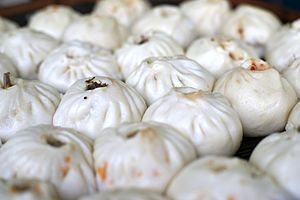
Many types of street foods, which differ by region, can be eaten as snacks or a light dinner. Prawn crackers are a common snack in Southeast China.
Dairy Products
In earlier times, Chinese people drank milk and ate dairy products. This might have been from mares (like kumis) or goats, not just cows.
Historically, many Chinese chefs avoided milk because many Chinese people are lactose intolerant. However, today, dairy products are used more in Chinese cooking. Examples include "double skin milk" dessert in Guangdong, Rubing cheese in Yunnan, and yoghurt in Qinghai and Xinjiang. China has many popular dairy desserts.
Cold Dishes
Cold dishes are usually served before the main meal. Besides salads and pickles, they can include jelly, beancurd, noodle salads, cooked meats, sausages, or even cold soups.
Chinese sausages vary by region. The most common is made of pork and pork fat. In Southern China, the flavor is usually salty-sweet. In other parts of China, sausages are salted to be preserved. Chinese sausage is cooked in many ways, like oven-roasting, stir-frying, and steaming.
Soups
In some parts of South China, soups are served between the cold dishes and the main courses. In other areas, soups come between the main dish and staple foods, before desserts or fruit. There are many traditional Chinese soups, such as wonton soup, herbal chicken soup, hot and sour soup, and winter melon soup.
Drinks
Tea is very important in Chinese dining. In China, there are two main types of tea: one made from dried tea leaves, and another made from tea extracts. Baijiu and huangjiu, which are strong alcoholic drinks, are also popular. Wine is not as common as other drinks during meals, but it is usually available.
Chinese Tea
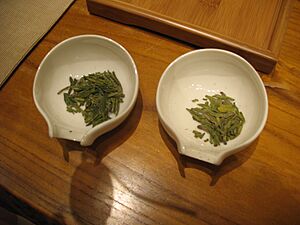
Many Chinese people drink tea with snacks like nuts, plums, dried fruit (especially jujube), small sweets, melon seeds, and waxberry. China was the first country to grow and drink tea. People from all walks of life enjoy it. Tea processing began after the Qin dynasty and Han dynasty.
Chinese tea comes in different types, including black, white, green, yellow, oolong, and dark tea. Tea is often grouped by the plant it comes from, where it's grown, and how it's made. Some well-known green teas include Longjing and Huangshan Maofeng. China is the world's largest exporter of green tea.
A common item in modern China is a double-walled insulated glass thermos with tea leaves inside.
Herbal Drinks
Chinese herb tea, also called medicinal herbal tea, is made from Chinese medicinal herbs.
Other Beverages
Soy milk, almond milk, walnut milk, and coconut milk are also drunk during meals in different regions. In some parts of China, hawthorn and jujube juice are preferred. A small shot of fruit vinegar is sometimes served as an appetizer in Shanxi.
Chinese Food Around the World
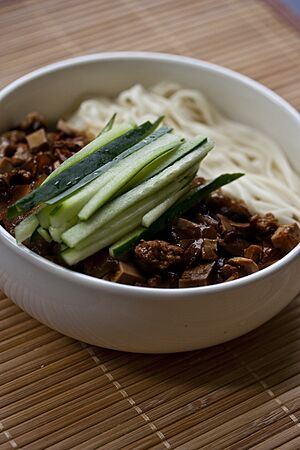
Where Chinese people have moved and settled, their food has changed. It has adapted to local tastes and ingredients. This has led to a strong Chinese influence on other national cuisines, like those in Cambodia, the Philippines, Singapore, Thailand, and Vietnam.
Chinatowns around the world have helped shape the food of their countries. For example, they brought a street food culture to Thailand in Bangkok. There are also many types of fusion cuisine, which mix Chinese and local styles. Some, like ramen (Japanese Chinese cuisine), which started in Yokohama Chinatown, have become popular globally.
Deep-fried meat with sweet and sour sauce is very popular outside of China. Many international Chinese dishes are based on this style. Examples include Sweet and Sour Chicken (Europe and North America), Manchurian Chicken (India), or tangsuyuk (South Korea).
The dishes developed in Chinese communities overseas often depend on where the immigrants came from in China. For example, Korean Chinese cuisine mostly comes from Shandong cuisine. Filipino Chinese cuisine is strongly influenced by Fujian cuisine. American Chinese cuisine has unique dishes like chop suey and orange chicken. These were originally based on Cantonese cuisine and are more popular with non-Chinese Americans than with Chinese Americans themselves.
- American Chinese cuisine
- Australian Chinese cuisine
- Mango pancake, dim sim, XO sauce pipis
- British Chinese cuisine
- Chicken balls, Jar jow
- Burmese Chinese cuisine
- Canadian Chinese cuisine
- Caribbean Chinese cuisine
- Cha chee kai, bangamary ding
- Filipino Chinese cuisine
- Indian Chinese cuisine
- Indonesian Chinese cuisine
- Japanese Chinese cuisine
- Korean Chinese cuisine
- Chinese Latin American cuisine
- Peruvian Chinese cuisine (Chifa)
- Puerto Rican Chinese cuisine
- Carne Ahumada
- Malaysian Chinese cuisine
- New Zealand Chinese cuisine
- Pakistani Chinese cuisine
Dining Etiquette in China
When eating, younger people should wait for their elders to start. When holding a bowl, you should not hold it from the very bottom. This is because it looks like begging. Chopsticks are the main tools for eating Chinese food. You can use them to cut and pick up food.
When you take a break from eating, do not put your chopsticks straight up in the rice. This looks like a traditional Chinese funeral offering. It is also considered rude to use knives at the dining table. You should not wave your chopsticks around or play with them. Always take food from the plate directly in front of you first. Staring at a plate is considered impolite. Watching TV, using phones, or doing other activities while eating is also seen as bad manners. If an older person puts food in your bowl, you should thank them.
Chinese culture has rules about how and when food is eaten. Chinese people usually eat three meals a day: breakfast, lunch, and dinner. Breakfast is around 6–9 am, lunch is around 12–2 pm, and dinner is around 6–9 pm. There's also a late-night meal called siu yeh, served from 9 pm to 4 am. This is similar to a Western supper.
Families follow different traditions. In some families, older members and young children eat first, then parents, then teenagers. Other families might have men and women eat separately. Whatever the tradition, it's meant to show respect to family members.
Food, Philosophy, and Religion
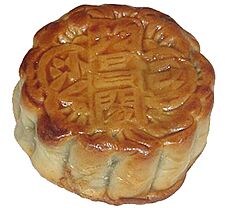
Food plays many roles in Chinese social and cultural life. In Chinese folk religion, people honor their ancestors by offering them food. Chinese festivals also involve eating and preparing special foods that have symbolic meanings. Different religions in China have their own cuisines, such as the Taoist diet, Buddhist cuisine, and Chinese Islamic Cuisine.
Food also plays a role in daily life. How formal a meal is can show the relationship between people. The type of food can also show someone's social status or where they come from. In a formal setting, up to sixteen hot and cold dishes might be served to honor guests. In a casual setting, people might eat inexpensive meals at food stalls or homemade food. Rich people might eat rare and costly foods like shark fins, while others eat more common foods.
The main food people eat, whether rice or wheat-based foods like bread or noodles, can suggest if they are from southern or northern China. Different foods have different symbolic meanings. Mooncakes and dumplings are symbols of the Mid-Autumn Festival and the Spring Festival, respectively. A pear symbolizes bad luck because its name sounds like "away" in Chinese. Noodles mean living a long life because of their length.
In Chinese philosophy, food often carries a message. A Chinese philosophy book, I Ching, says, "Gentlemen use eating as a way to attain happiness. They should be aware of what they say, and refrain from eating too much."
See also
 In Spanish: Gastronomía de China para niños
In Spanish: Gastronomía de China para niños



